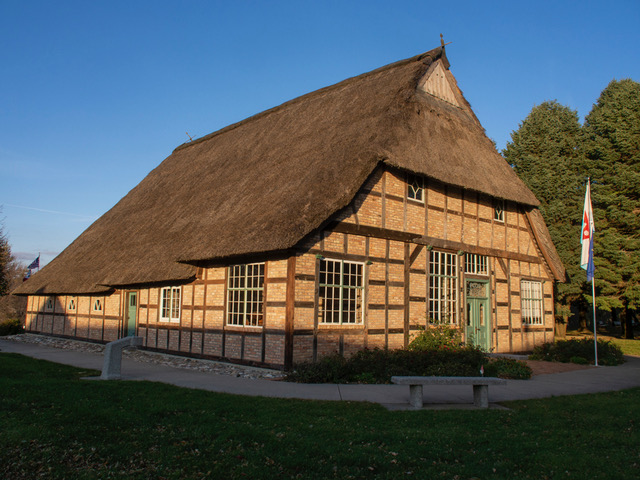Editor’s note: Wolf Koch submitted the press release and photo about his upcoming program.
On Sunday, August 13, 2023, Wolf Koch will discuss “A Comparison of Barns from Northern Germany, Denmark, and Iowa to Barns Built by Midwest Settlers.” It will be held at 2:00 p.m., in the Lincoln Learning Center, 611 E. Third Street, Sterling, IL. This presentation will provide a short overview of farmstead and barn construction in various parts of Germany and concentrate on the specific Hausbarns found in northern Germany and Denmark–the Hallenhaus and Haubarg farmsteads. While both the Manning, and DeWitt, IA, barns are Hallenhäuser (plural of Hallenhaus), there are no Haubarg-type barns in this Country. In fact, there are only about 100 of these very large barns left in Germany and Denmark.
Koch’s presentation will explore these traditional European farmsteads and compare them to those built later by German and Scandinavian immigrants here in the Midwest. It will also visit a German Farm Museum and discuss machinery used for small subsistence-level farming.
Barns have fascinated Midwestern City folks for decades; local periodic barn tours tend to draw hundreds, sometimes thousands, of visitors. Iowa has been blessed with citizen initiatives in two small towns to develop tourism opportunities, by bringing existing historic German barns from the Schleswig-Holstein region to their towns. In 1996, Manning brought a large, 1660 Hallenhaus barn (Hausbarn) from Klein Offenseth to Manning and reconstructed it as part of a Heritage Park. A decade later, DeWitt, IA, obtained a similar, but smaller, 1727 Hallenhaus from the village of Niebull and rebuilt it in the town center.
Both barns had been slated for demolition at their original German locations prior to disassembly and shipment to The United States of America. That was followed by renovation and reassembly, by local volunteers led by German craftsmen. In addition to the two original German Hausbarns located in Iowa, an extensive collection of reconstructed early immigrant farmsteads, adapted to local conditions, are located at the Wisconsin Historical Society’s Old World Wisconsin, open-air museum in Eagle, WI.
Wolf Koch grew up in Oberwinter, a small town dating back to 886, located in Germany’s Rhine Valley, halfway between Cologne and Koblenz. He immigrated to this Country some 60 years ago. A decade later, he was back in Germany for five years, as an officer in the U. S. Air Force, and he has been back on business and family visits almost annually. During his childhood, Wolf spent most school vacations on farms owned by siblings of both of his grandfathers and became quite familiar with everyday life on small German farms. He and his wife have been frequent visitors to both Iowa Hallenhäuser as well as Old World Wisconsin since 1978. Four years ago, they spent part of a vacation living in a Hallenhaus close to Husum, Germany, as well as a day visiting and photographing the Rote Haubarg, one of the largest, operating now as a restaurant and museum.
Wolf’s previous presentations include
1.capturing the Remagen Bridge and commemorating the end of World War II
2. the 500-year anniversary of the Reformation
3. the History of our favorite Food: Pizza
4. various local historic and photography topics.
He and his wife Linnea travel extensively; their interest in history has taken them to many European historical sites. Locally, they have given many talks on the Hopewell civilization in the Rock River Valley.
Wolf Koch is a consultant to the oil and petrochemical industries; he has been a Professor of Chemical Engineering and lectures on energy related topics and historical events.
Graphic Designer Linnea Koch specializes in exhibit design and interpretive signage. She is an accomplished photographer, who documented a decade of local Barn Tours via multimedia presentations.
Together, they teach Photography seminars and give presentations on Wildlife Photography.
